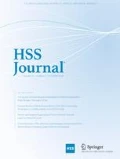Correction to: HSSJ
The published article listed an incorrect credential for Jose Rodriguez, MD. It is corrected here.
The correct article category should be “Response to COVID-19/Review Article.”
The published article also contained two typographic errors in Table 1, neither of which affected the data or findings presented. Table 1 is corrected here.
Organ system | Imaging findings |
|---|---|
Pulmonary manifestations | Plain radiograph (Fig. 1) • Consolidation and ground glass opacities (GGO) in a peripheral and lower lobe distribution, with predominately bilateral lung involvement• Pulmonary nodules, pleural effusions, lymphadenopathy, and lung cavitation are usually absent |
Chest CT findings based on time of illness (Figs. 2, 3, and 4)A. Early stage (days 0–4) • Subpleural unilateral or bilateral GGO • Negative findings possible in minority of patients B. Progressive stage (days 5–8) • Diffuse/multilobe distribution of GGO • Crazy-paving pattern (GGO with superimposed inter- and intralobular septal thickening) • Consolidations without mediastinal lymphadenopathy C. Peak stage (days 9–13) • Worsening GGO diffusion and crazy-paving with residual parenchymal bands • ARDS highly likely during this period D. Absorption stage (days 14–resolution) • GGO may persist, but crazy-paving resolves • Consolidations decrease over time | |
Other associated chest CT findings (Fig. 7) • Septal thickening • Pleural thickening • Pericardial effusion • Bronchiectasis • CT Halo sign • Acute pulmonary embolism (screen for deep vein thrombosis on duplex ultrasound) | |
Cardiovascular manifestations | Gadolinium-enhanced cardiac MRI and echocardiographs (Figs. 5 and 6) • Acute myopericarditis: curvilinear delayed enhancement in the subepicardial wall and adjacent pericardium • Acute myocardial infarction: delayed transmural enhancement within ventricle • Generalized increase in heart wall thickness • Diffuse biventricular hypokinesis • Severe left ventricular dysfunction • Biventricular myocardial interstitial edema • Pericardial effusion (mostly around the right cardiac chambers) |
Musculoskeletal and neurologic manifestations | CT brain (Figs. 8 and 9) • Acute large vessel cerebral infarcts (could be thromboembolic in nature) • Acute cerebral hemorrhage • Leukoencephalopathy, including CT hypoattenuation of the bilateral cerebral hemispheric white matter and corpus callosum |
MRI (with or without IV contrast) (Figs. 10, 11, and 12) • Encephalitis with leptomeningeal enhancement • Meningoencephalitis • Guillain-Barré syndrome (GBS) • Acute ischemic stroke with frontotemporal hypoperfusion abnormalities • Intracranial hemorrhage • Cerebral venous thrombosis • Multiple sclerosis plaque exacerbation • Miller-Fisher syndrome • Posterior reversible encephalopathy syndrome (PRES) • Acute necrotizing encephalopathy (ANE) • Leukoencephalopathy with diffuse confluent white matter T2/FLAIR hyperintensities, scattered micro-hemorrhage in the corpus callosum, and posterior circulation hyperperfusion, without diffusion restriction or abnormal enhancement • Myositis | |
Gastrointestinal manifestations | CT and US abdomen (Figs. 13 and 14) • Small and large bowel wall thickening, due to gastroenteritis or ischemia • Bowel and mesenteric infarction and necrosis, with associated non-enhancing bowel, pneumatosis, portal venous gas, and bowel perforation • Portal vein thrombosis • Distended gallbladder containing sludge suggestive of cholestasis • Solid organ inflammation and infarction, including the pancreas (pancreatitis), liver (hepatitis), kidneys, and spleen |
Author information
Authors and Affiliations
Corresponding author
Additional information
The online version of the original article can be found at https://doi.org/10.1007/s11420-020-09775-3
Rights and permissions
About this article
Cite this article
Reddy, G.B., Greif, D.N., Rodriguez, J. et al. Correction to: Clinical Characteristics and Multisystem Imaging Findings of COVID-19: An Overview for Orthopedic Surgeons. HSS Jrnl 16 (Suppl 1), 124–126 (2020). https://doi.org/10.1007/s11420-020-09811-2
Published:
Issue Date:
DOI: https://doi.org/10.1007/s11420-020-09811-2

